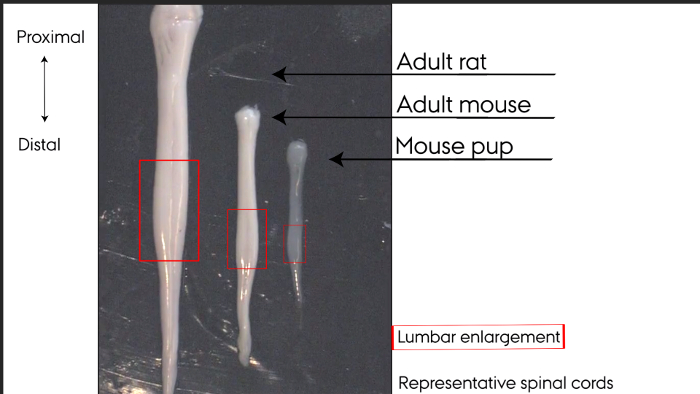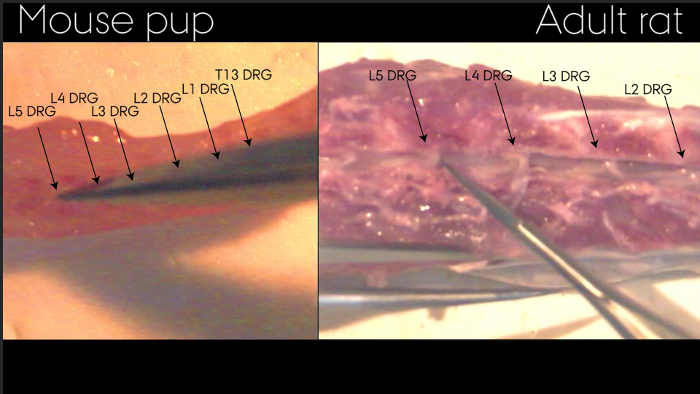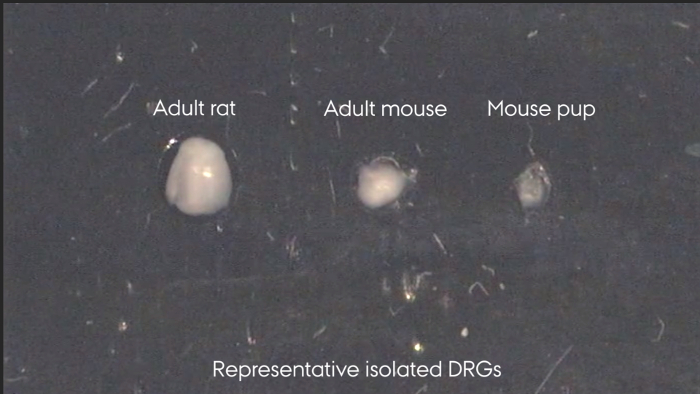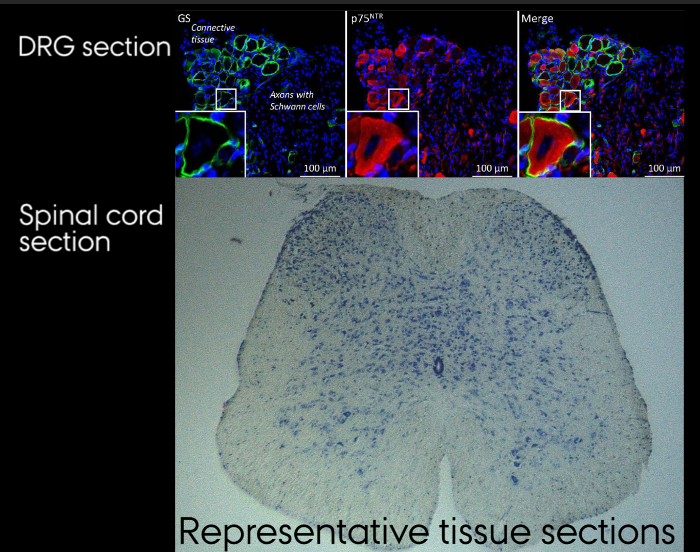Method Article
설치류의 등쪽 뿌리 신경절의 척수 및 절연의 유압 압출
요약
Here, we present a protocol for hydraulic extrusion of the spinal cord as well as identification and isolation of specific dorsal root ganglia (DRGs) in the same rodent. Compared to standard spinal cord isolation methods, this method is significantly faster and reduces the risk of tissue damage.
초록
Traditionally, the spinal cord is isolated by laminectomy, i.e. by breaking open the spinal vertebrae one at a time. This is both time consuming and may result in damage to the spinal cord caused by the dissection process. Here, we show how the spinal cord can be extruded using hydraulic pressure. Handling time is significantly reduced to only a few minutes, likely decreasing protein damage. The low risk of damage to the spinal cord tissue improves subsequent immunohistochemical analysis. By performing hydraulic spinal cord extrusion instead of traditional laminectomy, the rodents can further be used for DRG isolation, thereby lowering the number of animals and allowing analysis across tissues from the same rodent. We demonstrate a consistent method to identify and isolate the DRGs according to their localization relative to the costae. It is, however, important to adjust this method to the particular animal used, as the number of spinal cord segments, both thoracic and lumbar, may vary according to animal type and strain. In addition, we illustrate further processing examples of the isolated tissues.
서문
이 방법의 전체 목표는 척수를 분리뿐만 아니라, 2 DRGs 하나를 식별하고 분리한다. 척수의 유압 압출 한번에 척추 추체를 끊어서 즉 절제술에 의한 척수 분리의 전통적인 방법보다 훨씬 더 빠른 방법이며,이 방법은 박리 공정 3, 4에 의한 조직 손상의 위험을 줄여 . DRGs는 식별하기 어려울 수 있습니다. 올바른 식별은 예를 들어, 좌골 신경 손상에 따라 조직 분석을 위해 매우 중요하다. costae에 자신의 현지화 상대에 따라 DRGs 번호 매기기으로 DRGs는 지속적으로 식별 할 수 있습니다.
여기에 입증 된 기술에 의해 격리 조직, 웨스턴 블로 팅 (5)를 포함하여 분석의 넓은 범위에 적용 할 수 있습니다6, qPCR에 7, 면역 조직 화학 염색 (8).
DRGs를 식별 할 때, 척수 세그먼트의 수는 동물의 종류 및 균주도 9,도 10,도 11에 따라 변화하는 것으로 알려져 고려하는 것이 중요하다. 쥐에이 방법을 수행하는 장점은 가능한 유전자 변형 변형과 상대적으로 낮은 주택 비용의 높은 수 있습니다. 래트를 사용의 이점은 상대적으로 높은 수율 조직이며 신경 손상을 포함하는 경우, 절차는 크기가 완화 될 것이다.
프로토콜
모든 동물은 덴마크어와 유럽 규정을 준수에서 처리되었다. 허가 번호 : 2012-15-2934.
척수 유압 압출 용 주사기 1. 준비
- 성인 쥐를 들어, 10 ML의 주사기를 사용합니다. 성인 마우스를 들어, 5 ML의 주사기를 사용합니다. 새끼를 들어, 2.5 ML의 주사기를 사용합니다.
- 이 주사기에 단단히 맞을 때까지 피펫 팁의 넓은 끝을 트리밍하여 2-200 μL 피펫을위한 보편적으로 적합한 비 필터 피펫 팁을 조정합니다. 주사기에 조정 피펫 팁을 배치합니다. 새끼를 들어, 조정 피펫 팁 대신 23 G 또는 유사한 바늘을 사용합니다.
- 대기음 얼음처럼 차가운 멸균 PBS 추가로 사용할 때까지 얼음에 주사기를 둡니다.
2. 안락사
- 이것이 불가능 압출 렌더링 척추 척추을 방해하므로, 자궁 경부 전위를 수행하지 마십시오.
- 성인 쥐 / 마우스를 들면, CO 2 isoflu으로 가스를 사용 안락사RANE. 이러한 물질은 유해하다. 흄 후드에서 안락사를 수행하고 기관의 지침에 따라 물질을 처리합니다. (주의 : CO 2 : H280, P410, P403, 이소 플루 란 : H361d, P260, P281, P280)
- 설치류가 죽은 것을 보장하기 위해, 핀셋과 발을 곤란하게하여 반사의 부재를 확인합니다. 큰 가위를 사용하여 쥐 목을 벨. 새끼를 들어, 잘린에 의해 안락사.
척추 3. 분리
- 머리를 제어하기 위해 모피에 물을 뿌린다.
- 가위를 사용하여, 원위 방향으로 척주를 따라 절개 모피 골반 뼈 과거 척주를 따라 양측에 절단하여 척추를 분리. 가위와 골반 뼈 말단 척수를 잘라.
참고 : 주동이의 - 꼬리 축이 프로토콜을 통해 근위 - 원위부 축으로 표시된다.- proximal-을 피하기 위해 가위를 사용하여 척주 트림이들과 같은 대부분 말초 - 대부분의 지역이 너무 성공적으로 척수 압출 S 자형 척추를 렌더링 할 수 있습니다. 척수는 양쪽 끝에서 볼 수 있는지 확인하십시오. 척수가 보이지 않으면 척수가 표시 될 때까지, 가위 척추 트림.
척수 4. 유압 압출
- 얼음에 멸균 PBS로 가득 페트리 접시 (직경 100mm) 놓습니다.
- 따라서 가능한 한 많은 척추를 교정, 척추의 절곡 부 (근위 가장 끝)에 검지 손가락을 적용하여 척추를 똑 바르게.
- 척추가 불가능 척수 압출 렌더링 중단 될 것 같은 새끼를 들어, 척추가 구부러지지 않도록.
- 피펫 팁 척추의 말단 가장 마지막에 (새끼 23 G 바늘, 성인 마우스에 대한 대안으로 18 G 바늘)를 삽입합니다. 올바르게 삽입하면 팁은 척수 공동으로 안정화된다.
- 척추는 가능한 한 곧게되어 있는지 확인합니다. 꾸준한 압력을 적용하고 얼음에 페트리 접시에 척수을 돌출. 척수가 더 처리 될 때까지 PBS에서 유지하여 얼음에 습기가 유지되어 있는지 확인합니다.

그림 1 : 대표 척수. 유압 척수를 압출. 성인 쥐, 성인 마우스, 마우스 강아지 : 왼쪽에서 오른쪽으로. 요추 확대 한 상자로 표시. 이 그림의 더 큰 버전을 보려면 여기를 클릭하십시오.
등쪽 뿌리 신경절 5. 확인 (DRGs)
- 가위를 사용하여 두 개의 동일한 길이 부분의 척추를 분할하고 현미경으로 분할 척추를 배치합니다.
- 하여 T13 척추 세그먼트를 식별 척추 신경을 쓰는에 말초 가장 costae의 부착 위치를 찾는 것은 인근 늑간 신경과 costae을 혼동하지. 원위 가장 costae는 근위 T13 척추 세그먼트 부분과 T13 DRG이 L1을 위해 척추 말단 척추 T13 및 근위 위치에 부착된다.
- 말단 방향으로 수반 DRGs를 확인합니다. 성인 쥐의 경우, 수반되는 DRGs 명확하게 볼 수 지느러미와 복부 뿌리 흰색 나타납니다. 성인 마우스의 경우, 수반되는 DRGs 명확하게 볼 수 지느러미와 복부 뿌리 흰색 나타납니다. 강아지의 경우, 수반되는 DRGs는 명확 분야 나타납니다.

그림 2 : 척수의 압출 후 척추에 DRGs의 식별. 척주는 화살표로 표시된 바와 같이 DRGs 시각화 있도록 분할되어있다. 성인 쥐와 마우스 강아지 예시. 심판 = "http://ecsource.jove.com/files/ftp_upload/55226/55226fig2large.jpg"대상 = "_ 빈">이 그림의 더 큰 버전을 보려면 여기를 클릭하십시오.
DRGs 6. 분리
- 특정 DRGs에 따라 번호 페트리 접시 (직경 30 mm)를 예를 들어, L3, L4, L5, 격리합니다. 얼음처럼 차가운 멸균 PBS와 페트리 접시를 입력하고 얼음에 배치합니다.
- DRGs의 손상을 피하면서 가능한 한 DRGs에 가까운 마이크로 가위, 절단 지느러미와 복부 뿌리를 사용하여 그것들을 분리합니다.
- 폐쇄 핀셋의 끝으로 부드럽게 DRGs을 특종과 해당 번호 배양 접시로 전송.

그림 3 : 대표 DRGs를 격리합니다. 성인 쥐, 성인 마우스, 마우스 강아지 : 왼쪽에서 오른쪽으로."_blank">이 그림의 더 큰 버전을 보려면 여기를 클릭하십시오.
또한 분석을위한 조직 7. 처리
- 웨스턴 블로 팅
- 척수의 요부 확대 예컨대, 관심 조직 영역을 격리. 필요한 경우, 동측 및 반대측면에 추가 지느러미와 복부 뿔에 척수를 분리합니다.
- 이러한 얼음에 적절한 효소 억제제를 포함하는 (더블 증류수 H 2 O에서 10 mM 트리스 - 염기, 150 mM의 염화나트륨, 1 mM의 EDTA, 1 % NP40) TNE 용해 버퍼로 용해 버퍼에서 조직을 놓습니다.
- 기계 연삭 유 봉을 사용하여 얼음에 약 30 초 동안 조직을 균질화.
- 4 ° C에서 16,000 XG에 15 분 동안 원심 분리기 및 표준 프로토콜 5, 6에 따라 추가 처리를 위해 상층 액을 사용하거나 더 사용할 때까지 -20 ° C에서 뜨는을 유지한다.
- RNA 분석
- 관심있는 조직을 분리합니다.
- 즉시 저장을 위해 RNA를 안정화 RNA 안정화 용액 조직을 놓는다.
- 표준 프로토콜 7에 따라 RNA를 분리합니다.
- 의 cDNA에 RNA를 변환 한 표준 프로토콜 7에 따라 qPCR에를 수행합니다.
- 면역 조직 화학
- (척수에 적용) 신선한 냉동 조직의 경우 :
- 분말의 두 큰술에 해당하는 양 드라이 아이스 큐브를 분쇄하여 드라이 아이스 분말을 준비합니다. 천에 드라이 아이스 큐브를 덮고 망치를 사용하여 큐브를 분쇄. 드라이 아이스 큐브의 층에 실버 호일 (약 5cm X 5cm)를 놓고 드라이 아이스 분말 실버 호일 커버.
- 핀셋을 사용하여 드라이 아이스 분말을 추가 분석을 위해 선택된 척수 영역을 놓고,이 스냅인 냉동 및 냉동 튜브 척수 전송하자. 항상 드라이 아이스에 그것을 유지하거나 우리를 더욱 때까지 -80 ° C에서 보관이자형.
- 그라 이오 스탯에 척수로 이동 (-20 ° C). 필요한 경우, 내부 저온 유지 척수 트림. 시험편 디스크에 부착하기 위하여 저온 유지 장치 내부 물질을 매립에서 척수를 배치했다.
- 예를 들어, 5 μm의 원하는 두께 척수 절단하고, 유리판 상에 수집한다. 더 부착 조직 수집 직전 손가락으로 유리판을 가열한다. 더 사용할 때까지 -80 ℃에서 냉동 튜브에 남은 조직을 유지합니다.
- 후 고정을위한 준비가 될 때까지 저온 유지 장치 내부에 유리 접시에 섹션을 둡니다.
- 실온에서 10 분 동안 4 % PFA로 침지하여 섹션 포스트 픽스.
- 표준 프로토콜 8 항에 염색 수행합니다.
- (척수 및 DRGs에 적용) 크라이 절편에 대한 고정 조직
- 4 % PFA (척수를위한 2 시간, 마우스 DRGs 1.5 시간과 쥐 DRGs 4 시간)에서의 척수 및 DRGs 수정4 ° C (수평 위치에 자리 척수는 구부러진 위치에 고정되는 것을 방지하기 위해).
- 4 ℃에서 하룻밤 / V 자당 승 25 %에 조직을 전송합니다. 티슈는 더 사용할 때까지 4 ℃에서의 미생물 오염을 방지하기 위해 10 %의 아 지드 화 나트륨 몇 방울 첨가 / V 자당 승의 25 %에 저장 될 수있다. 필요한 경우에만 실리콘 기판 또는 유사한에서 요추 확대를 만들기 위해 척수 트림.
- 종이 타월의 팁을 사용하여 조직으로부터 과량의 수크로오스 용액 대기음.
- 재료를 포함와 냉동 금형을 반쯤 채우십시오. 이러한 폐쇄 핀셋 같은 도구와 크라이 금형의 측면에 대한 거품을 밀어 넣습니다.
- 핀셋을 사용하여 매립 재료의 조직을 놓고 원하는 조직의 방향을 확인합니다.
- 자료를 포함하여 완전히 냉동 금형을 작성하고 멀리 (폐쇄 핀셋을 사용하여 예) 가능한 한 조직에서 어떤 거품을 밀어 넣습니다.
- (100mm를 페트리 접시를 채우2- 메틸 부탄 직경)이다. 이 물질은 유해하다. 흄 후드에서이 단계를 수행하고 기관의 지침에 따라 물질을 처리 (주의 : H224, H304, H336, H411, P210, P280, P273, P301, P331, P304 / P340, P309 / P310).
- 드라이 아이스의 층에 페트리 접시를 놓고 페트리 접시에 두 드라이 아이스 큐브를 추가합니다. 페트리 접시에 크라이 금형을 놓고 삽입 물질이 완전히 정지 할 수 있습니다.
- 항상 드라이 아이스에 포함 된 조직을 유지하거나 추가 처리 할 때까지 파라 필름에 싸여 -80 ° C에서.
- 그라 이오 스탯 (-20 ° C)에서 원하는 두께의 조직, 예를 들어 5 μm의 컷.
- 표준 프로토콜 8 항에 염색 수행합니다.
- (척수 및 DRGs에 적용) 파라핀 삽입에 대한 고정 조직
- 4 ° C (장소 척수에서 4 % PFA (척수를위한 2 시간, 마우스 DRGs 1.5 시간과 쥐 DRGs 4 시간)에 척수 및 DRGs 수정수평으로) 절곡 위치에서 고정되는 것을 방지한다.
- 4 ℃에서 하룻밤 / V 자당 승 25 %에 조직을 전송합니다. 티슈는 더 사용할 때까지 4 ℃에서의 미생물 오염을 방지하기 위해 10 %의 아 지드 화 나트륨 몇 방울 첨가 / V 자당 승의 25 %에 저장 될 수있다.
- 척수의 요부 확대 예컨대, 관심 조직 영역을 격리.
- 파라핀과 함께 포함 금형을 반쯤 채우십시오.
- 약간 파라핀 경화 매립 장치의 냉각 영역에 배치하여 매립 금형 간단히 냉각. 이것은 더 나은 조직 포지셔닝 수 있습니다.
- 매입 형에서 원하는 방향으로 조직을 놓습니다. 파라핀으로 포함 금형을 입력하고 즉시 냉각.
- 완전히 경화 및 포함 금형의 조직을 포함하는 파라핀 블록을 제거 할 수 있도록 4 ° C에서 밤새 파라핀 함유 포함 금형을 배치합니다.
- 컷 섹션 오원하는 두께 NA 마이크로톰 예는 5㎛.
- 표준 프로토콜 8 항에 염색 수행합니다.
- (척수에 적용) 신선한 냉동 조직의 경우 :
결과
유압 압출 척수는 그림 1과 같이 부드러운 손상되지 않은 표면을 표시합니다. 요부 확대도 용이 한 박스형 척수의 두꺼워 진 영역으로 식별 될 수있다. 척수의 등 및 복부면은 형태에 따른 눈으로 확인할 수있다. 그림 1에서, 복부 측면은 전체 척수을 따라 분명 중간 선에 의해 식별 뷰어를 직면하고있다. 척수를 따라 두 폭 넓은 라인은 등쪽의 식별을 할 수 있습니다. 원위 가장 마지막에 마미 때때로 성인 쥐 성인 쥐에 부착 된 상태로 유지된다.
척주,도 2에있는 동안 개별 DRGs 만 식별 될 수있다. 격리,도 3에 따라, 개별 DRGs는 외관에 의해 식별 될 수 없다. 필요한 경우, 그러므로그들을 유지하는 것이 중요 명확하게 분리시 분리. 단계 7.3에 설명하고도 4에 나타낸 바와 같이 분리 한 후, 척수 DRGs 처리하고 염색 할 수있다. 도 4a는 신경 세포 및 그 주변 위성 신경교 세포가 분명히 표시되어 DRG 섹션의 면역 조직 화학 염색을 보여준다. DRG 올바르게 식별하여이 손상된 뉴런의 소마뿐 아니라 그 주변 위성 신경교 세포의 좌골 신경 손상의 효과를 분석 할 수있다. 도 4b는 부분의 매끄러운 가장자리 반영된 조직 그대로 수압 압출 척수의 Nissl 염색을 보여준다.

그림 4 : 대표 조직 섹션. 를했다. DRG 섹션의 면역 조직 화학 염색. B. Nissl 스테인드 SECTIO유압 압출 척수 N. 이 그림의 더 큰 버전을 보려면 여기를 클릭하십시오.
토론
척주는 경부 탈구에 의해 예, 방해되는 경우, 척수 압출 동안 분할된다. 척수가 압출 될 수없는 경우, 척주의 양 끝은 약간 줄어들 수 있으며 압출 시도가 반복 될 수있다. 경우 전체 척수 즉 경부 확대뿐만 아니라 요추 확대 구성된 추가 분석을 위해 필요한, 척추는 약간 정돈한다. 단 요추 확대는 추가 분석을 위해 필요하다면, 척수 본 프로토콜에 따라 트리밍한다. 척추는 압출을 용이하게하기 위해 손가락을 사용하여 곧게해야합니다.
이 프로토콜은 모든 연령의 설치류에 적용 가능하고 여기 성체 마우스 (8 주), 마우스 새끼 (5 일) 및 성인 쥐 (10 주)을들 수있다. 동물의 종류 및 변형에 따라 흉추 및 요추 부분의 수는 달라질 수 9 10, 11. 단백질에 따라서는 성인 설치류 전에 안락사에 효소 억제 솔루션을 관류 할 수있다, 분석 할 수 있습니다. 한면 신경 손상과 관련된 실험을 행하는 경우, 척수 압출 직후 초 미세 핀셋을 이용하여 동측과 반대측면으로 분할 할 수있다. 또한, 각면은 지느러미와 복부 양쪽으로 분할 할 수 있습니다. 티슈는 상기 분석, 웨스턴 블롯 등을 위해 처리 될 수있다.
이 척수가 아닌 유연한 렌더링 및 척수 유압 압출 방지로 척수 압출 전에 PFA와 Transcardial 관류 - 고정은 피해야한다. 유압 척수 압출 지느러미 뿌리를 떼어 것입니다. 부착 등의 뿌리가 필요한 실험을 위해, 추궁 절제술을 권장합니다. 또한, 척수 수막 표준 추궁 절제술 방지 할 수 있습니다 유압 압출에 의해 손실 3.
척수 및 DRG 분리의 유압 압출 대신 얼음처럼 차가운 PBS의 산소 인공 뇌척수 (ACSF)를 사용하여 수행 할 수 있습니다. ACSF의 사용은 후속 전기 생리 학적 기록 (12, 13)의 경우에 특히 중요하다 더 생리적 환경에서 분리 된 조직을 보존 할 수있다. ACSF에 대한 대안은 PBS가 1g / 차 DRG 문화 (14)의 생성을위한 L 포도당을 포함 수 있습니다.
척수의 유압 압출 절제술에 의한 척수 절연 전통적인 방법, 조직 처리 시간을 감소시키고, 따라서 단백질 손상의 위험을 감소보다 훨씬 더 빠른 방법이다. 고정액으로 관류 전에 박리 과정 및 최종 제거시에 조직 손상의 위험을 감소시킬 수있다 절제술에 의한 척수를 분리로척추에서 척수. 그러나 조직의 고정은 웨스턴 블로 팅 등의 분석에의 적용 가능성을 배제. 유압 압출 수율 분석의 넓은 범위에 적합한 구조적 손상되지 않은 조직 3.
DRGs의 일관된 식별이 어려울 수 있습니다. 그러나, 이것은 예를 들면 좌골 신경 손상에 따라, 조직 분석을 위해 필수적이다. costae에 자신의 현지화 상대에 따라 DRGs 번호 매기기으로 DRGs는 지속적으로 식별 할 수 있습니다. DRGs 현재뿐만 척수 조직 염색 프로토콜 단계 7에 설명 된 예시 조직 치료의 변형을 수행하여 최적화 될 수있다.
공개
The authors have nothing to disclose.
감사의 말
We would like to acknowledge David Kiel, Aarhus University, for filming and editing. VirtualDub software was used for processing of microscope video sequences. We thank the Danish Research Institute of Translational Neuroscience - DANDRITE, Nordic EMBL Partnership, for access to equipment and the Aarhus University Research Foundation, EU 7FP project PAINCAGE, Det Frie Forskningsrad (DFF) and The Lundbeck Foundation for funding.
자료
| Name | Company | Catalog Number | Comments |
| Bonn scissors, extra fine, straight, 8.5 cm | F.S.C. (Fine Science Tools) | # 14084-08 | For cutting open the spinal cord prior to isolation of DRGs (adult mouse, adult rat); Other manufacturer may be used |
| Centrifuge | Eppendorf | # 5427 R | For centrifugation of homogenized tissue |
| Cryostat microtome | Leica Biosystems | # CM 3050 S | For cutting the embedded tissue prior to staining; Other model and manufacturer may be used |
| Forceps, Dumont, # 3 | F.S.C. (Fine Science Tools) | # 11231-30 | For handling of spinal cord after extrusion; Other manufacturer/type may be used |
| Forceps, Dumont, # 5 | F.S.C. (Fine Science Tools) | # 11252-20 | For isolation of DRGs (adult mouse, adult rat, pup); Other manufacturer may be used |
| Isoflurane (furane) IsoFlo Vet 100% | Abbott | # 002185 | For euthanization; Other manufacturer may be used; CAUTION: toxic |
| Iso-pentane GPR rectapur | VWR chemicals | # 24872.298 | For snap-freezing of tissue; Other manufacturer may be used; CAUTION: toxic |
| Microtome | Leica Biosystems | # RM 2155 | For sectioning of paraffin embedded tissue; Other model and manufacturer may be used |
| Paraffin wax pellets | Sigma-Aldrich | # 76243 | For paraffin embedding; Other manufacturer may be used |
| Paraffin tissue embedding station | Leica Biosystems | # EG1160 | For paraffin embedding of tissue for later sectionning; Other model and manufacturer may be used |
| Pellet pestel, motor cordless | Sigma-Aldrich | # Z359971-1EA | For mechanical homogenization of isolated tissue prior to Western blotting; Other manufacturer may be used |
| Petri dish, 35 mm | Thermo Fischer Scientific | # 121V | For storage of isolated DRGs; Other manufacturer and size may be used |
| Petri dish, 100 mm | Sigma-Aldrich | # P7741 | For spinal cord extrusion; Other manufacturer and size may be used |
| Phosphatase inhibitor, Phosstop | Sigma-Aldrich | # 04906845001 | Phosphatase inhibitor cocktail for addition to TNE-lysis buffer if needed; Other manufacturer may be used |
| Pipette tip, 1-200 μL, no filter | Sarstedt | # 70.1189.105 | For hydraulic extrusion; Other manufacturer may be used |
| Protease inhibitor, Complete | Sigma-Aldrich | # 05892791001 | Protease inhibitor cocktail for addition to TNE-lysis buffer if needed; Other manufacturer may be used |
| RNAlater solution | Sigma-Aldrich | # R0901 | For RNA stabilization for storage; Other manufacturer may be used |
| Rneasy Protect Mini KiT | Qiagen | # 74124 | For RNA isolation; Other manufacturer may be used |
| Scalpel; Swann-Morton surgical blade no. 11 | Swann-Morton | # REF0203 | For isolation of spinal cord lumbar area; Other manufacturer/type may be used |
| Scissors, straight, type 3, 25 mm cutting edge | Bochem | # 4070 | For isolation of spine; Other manufacturer/type may be used |
| Scissors, 130 mm cutting edge | Hounisen | # 1902.0130 | For isolation of spinal cord (adult rat) |
| Spring scissors, straight, 8 mm cutting edge | F.S.C. (Fine Science Tools) | # 15009-08 | For cutting open the spinal column prior to isolation of DRGs (pup) and for isolation of DRGs (adult mouse, adult rat, pup); Other manufacturer may be used |
| Standard syringes, 2.5 mL, 5 mL, 10 mL | Terumo | # SS02SE1; # SS05SE1; # SS10SE1 | For hydraulic extrusion; Other manufacturer may be used |
| Stereomicroscope MZ12.5 with objective 1X and eyepiece 10X | Leica | # 10446370 | Other manufacturer/type may be used |
| Sterile PBS | GIBCO | # 10010-015 | For hydraulic extrusion; Can also be made according to standard protocols |
| Syringe needle 23 G x 1", 0.6 x 25 mm | Terumo Neolus | # NN-2325R | For hydraulic extrusion in pups; Other manufacturer/type may be used |
| Syringe needle 18 G x 1 1/2, 1.2 x 40 mm | Terumo Neolus | # NN-1838S | Alternative to pipette tip for hydraulic extrusion in adult mice; Other manufacturer may be used |
| Tissue-Tek | Sakura | # 4583 | Tssue embedding material for later cryosectionning |
| TNE-lysis buffer | VWR chemicals | # 10128-582 | For tissue lysis prior to Western blotting; Other manufacturer may be used; Can also be made according to standard protocols |
참고문헌
- Malin, S. A., Davis, B. M., Molliver, D. C. Production of dissociated sensory neuron cultures and considerations for their use in studying neuronal function and plasticity. Nat Protoc. 2 (1), 152-160 (2007).
- Sleigh, J. N., Weir, G. A., Schiavo, G. A simple, step-by-step dissection protocol for the rapid isolation of mouse dorsal root ganglia. BMC Res Notes. 9, 82(2016).
- Kennedy, H. S., Jones, C. 3rd, Caplazi, P. Comparison of standard laminectomy with an optimized ejection method for the removal of spinal cords from rats and mice. J Histotechnol. 36 (3), 86-91 (2013).
- Meikle, A. D., Martin, A. H. A rapid method for removal of the spinal cord. Stain Technol. 56 (4), 235-237 (1981).
- JoVE Science Education Database. The Western Blot. , JoVE. Cambridge, MA. http://www.jove.com/science-education/5065/the-western-blot (2016).
- Gallagher, S., Chakavarti, D. Immunoblot analysis. J Vis Exp. (16), (2008).
- Ogrean, C., Jackson, B., Covino, J. Quantitative real-time PCR using the thermo scientific Solaris qPCR assay. J Vis Exp. (40), (2010).
- Crosby, K., et al. Immunohistochemistry Protocol for Parraffin-embedded Tissue Sections - ADVERTISEMENT. , JoVE. Cambridge, MA. https://www.jove.com/video/5064/immunohistochemistry-protocol-for-paraffin-embedded-tissue-sections (2014).
- Watson, C., Paxinos, G., Puelles, L. The Mouse Nervous System. , 1st edition, Academic Press, Elsevier. 424-426 (2012).
- Rigaud, M., et al. Species and strain differences in rodent sciatic nerve anatomy: implications for studies of neuropathic pain. Pain. 136 (1-2), 188-201 (2008).
- Green, E. L. Genetic and non-genetic factors which influence the type of the skeleton in an inbred strain of mice. Genetics. 26 (2), 192-222 (1941).
- Meyer, A., Gallarda, B. W., Pfaff, S., Alaynick, W. Spinal cord electrophysiology. J Vis Exp. (35), (2010).
- Ciglieri, E., Ferrini, F., Boggio, E., Salio, C. An improved method for in vitro morphofunctional analysis of mouse dorsal root ganglia. Ann Anat. , 62-67 (2016).
- Peeraer, E., et al. Pharmacological evaluation of rat dorsal root ganglion neurons as an in vitro model for diabetic neuropathy. J Pain Res. 4, 55-65 (2011).
재인쇄 및 허가
JoVE'article의 텍스트 или 그림을 다시 사용하시려면 허가 살펴보기
허가 살펴보기더 많은 기사 탐색
This article has been published
Video Coming Soon
Copyright © 2025 MyJoVE Corporation. 판권 소유